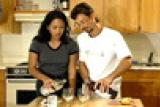Conceptual Chemistry
Chapter 3: Elements of Chemistry
A compound is a material made of at least two different elements. How a compound is uniquely different from the elements from which it is made is discussed. Duration: 8:01.
Kai and Maile demonstrate the Oxygen Bubble Bursts Hands-On Chemistry activity. Note that a long match stick should be used so that the flame that flares up in the yeast-containing glass doesn't give you a burn. Duration: 3:01.
For this third episode we interview Brian Pritchard an expert in the area of team based activities and human performance. Attention is given to the value of team-based learning in the classroom and beyond. This is followed by a review of Conceptual Chemistry’s foundational Chapter 3, Elements of Chemistry. Topics include physical and chemical changes, the periodic table, elements and compounds, mixtures, and nanotechnology.
Each episode is about an hour long and available for download or subscription to your portable device.
Show notes available at ConceptualScience.com/Podcasts
Watch these additional videos to complete this tutorial.
Table of Videos
- Chapter 1: About Science
- Chapter 2: Particles of Matter
- Chapter 3: Elements of Chemistry
-
Chapter 4: Subatomic Particles
- 4.1 Physical and Conceptual Models
- 4.2 Discovering the Electron
- 4.3 Discovering the Atomic Nucleus
- 4.4 Protons and Neutrons
- 4.5 Light Is a Form of Energy
- 4.6 Atomic Spectra and the Quantum Hypothesis
- 4.7 Electrons Exhibit Wave Properties
- 4.8 Orbitals and Energy-Level Diagrams
- 4.9 The Shell Model and Periodic Table (Plus Chapter Review)
-
Chapter 5: The Atomic Nucleus
- 5.1 Unstable Nuclei
- 5.2 Radioactivity Is Natural
- 5.3 An Imbalance of Forces
- 5.4 Transmutation
- 5.5 Radioactive Half-Life
- 5.6 Isotopic Dating
- 5.7 Nuclear Fission
- 5.8 Mass and Energy
- 5.9 Nuclear Fusion (Plus Chapter Review)
-
Chapter 6: How Atoms Bond
- 6.1 Electron-Dot Structures
- 6.2 Ion Formation
- 6.3 Ionic Bonds
- 6.4 Metallic Bonds
- 6.5 Covalent Bonds
- 6.6 Molecular Shape
- 6.7 Polar Covalent Bonds
- 6.8 Molecular Polarity (Plus Chapter Review)
-
Chapter 7: How Molecules Mix
- 7.1 Dipole Attractions
- 7.2 Solutions
- 7.3 Concentration and the Mole
- 7.4 Solubility
- 7.5 How Soap Works
- 7.6 Softening Hard Water
- 7.7 Purifying Drinking Water (Plus Chapter Review)
-
Chapter 8: How Water Behaves
- 8.1 Open Structured Crystals
- 8.2 Melting and Freezing
- 8.3 The Stickiness of Water
- 8.4 Liquid and Gaseous Phases
- 8.5 Water's Specific Heat
- 8.6 Phase Changes and Energy (Plus Chapter Review)
-
Chapter 9: How Chemicals React
- 9.1 Chemical Equations
- 9.2 Measuring Molecules
- 9.3 Grams and Moles
- 9.4 Exothermic or Endothermic
- 9.5 Entropy and Chemical Reactions
- 9.6 Chemical Kinetics
- 9.7 Chemical Catalysts (Plus Review)
- 9.8 Chemical Equilibrium
-
Chapter 10: Acids and Bases
- 10.1 Exchanging Protons
- 10.2 Acid and Base Strength
- 10.3 Acidic, Basic, or Neutral
- 10.4 Buffers Resist pH Changes
- 10.5 Rainwater Is Acidic
- Ocean Acidification (Plus Chapter Review)
-
Chapter 11: Oxidations and Reductions
- 11.1 Losing and Gaining Electrons
- 11.2 Harnessing the Energy
- 11.3 Electricity from Batteries
- 11.4 Electricity from Fuel Cells
- 11.5 Energy from Photovoltaics
- 11.6 Electrolysis Produces Change
- 11.7 Producing Metals
- 11.8 Corrosion and Combustion (Plus Chapter Review)
-
Chapter 12: Organic Compounds
- 12.1 Hydrocarbons
- 12.2 Unsaturated Hydrocarbons
- 12.3 Functional Groups
- 12.4 Alcohols, Phenols, and Ethers
- 12.5 Amines and Alkaloids
- 12.6 Carbonyl Compounds
- 12.7 Organic Synthesis
- 12.8 Polymer Chemistry
- 12.9 History of Plastics (Plus Chapter Review)
-
Chapter 13: Nutrients of Life
- 13.1 Biomolecules
- 13.2 Carbohydrates
- 13.3 Lipids
- 13.4 Proteins
- 13.5 Nucleic Acids
- 13.6 Vitamins and Minerals
- 13.7 Metabolism
- 13.8 A Healthy Diet (Plus Chapter Review)
-
Chapter 14: Medicinal Chemistry
- 14.1 Medicines Improve Health
- 14.2 The Lock-and-Key Model
- 14.3 Chemotherapy
- 14.4 The Nervous System
- 14.5 Psychoactive Drugs
- 14.6 Pain Relievers
- 14.7 Medicines for the Heart (Plus Chapter Review)
-
Chapter 15: Optimizing Food Production
- 15.1 Humans Eat at All Trophic Levels
- 15.2 Plants Require Nutrients
- 15.3 Soil Fertility
- 15.4 Natural and Synthetic Fertilizers
- 15.5 Pesticides Kill Pests
- 15.6 Past Agricultural Practices
- 15.7 Quality Agricultural Practices (Plus Chapter Review)
-
Chapter 16: Water and Air Resources
- 16.1 Water on the Move
- 16.2 The Water We Consume
- 16.3 How We Pollute Water
- 16.4 Wastewater Treatment
- 16.5 The Earth’s Atmosphere
- 16.6 How We Pollute Air
- 16.7 Global Warming (Plus Chapter Review)
-
Chapter 17: Capturing Energy
- 17.1 Energy through Electricity
- 17.2 Fossil Fuels
- 17.3 The Nuclear Industry
- 17.4 Sustainable Energy Sources
- 17.5 Hydroelectricity
- 17.6 Biomass Is Chemical Energy
- 17.7 Direct Solar Energy
- 17.8 Solar Fuels (Plus Chapter Review)
- Review





